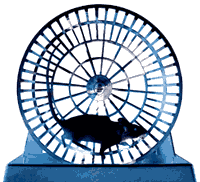10 Reasons to Be Concerned about Psychiatry in Our Schools
BY JOHN BREEDING, PH.D.

|
||
Something dark and dangerous is at work, creating this in our schools — something behind what comes to mind for most parents who, watching the evening news, see only the surface evils of sexual predation, gang violence or hoodlums selling illicit drugs in the corner of the schoolyard. The underlying danger is biological psychiatry, the conduit for stigmatizing and drugging our children.
The systematic killing of children’s love of learning is calamitous. What follows are 10 reasons to sound the alarm about psychiatry in schools:
1. An estimated 9 million U.S. schoolchildren take psychiatric drugs today. This number represents a greater than 700 percent increase in the last decade.
2. Psychiatrists cannot document one positive, long-term effect of these drugs on learning, academic performance or social behavior.
3. Parents and schools are inundated with incomplete, misleading and false information about psychiatric diagnoses and psychiatric drugs. The psychiatric diagnoses for which these drugs are prescribed, including Attention-Deficit/Hyperactivity Disorder (ADHD), have not been scientifically validated as real diseases.
4. With psychiatrists at the marketing forefront, 90 percent of the world’s methylphenidate* production is consumed in the United States — mostly by schoolchildren.
5. School personnel pressure parents to have their children evaluated and placed on psychiatric drugs. Lawmakers must clarify that this is illegal; parents should know that such psychiatric coercion should be barred from their children’s schools.
6. Psychiatric drugs harm young bodies, including cardiovascular, endocrine, respiratory and central nervous systems.
7. Psychiatric drugs cause death. Food and Drug Administration (FDA) adverse reaction report data include 186 methylphenidate-related deaths during the 1990s, mostly cardiovascular-related. These voluntary FDA reports represent only a fraction (experts estimate between 1 and 10 percent) of the actual incidents.
8. Psychiatric drugs are consistently linked to violence in the schools. Research shows that aggressive and injurious behavior toward self or others can result from the drugs, especially the so-called Selective Serotonin Reuptake Inhibitors (SSRIs) — while taking them or during withdrawal.
9. Psychiatric drugs increase the risk of suicide, self-mutilation and other forms of violence. For such reasons, one widely prescribed antidepressant, paroxetine, has been banned by the state of Connecticut for prescription to anyone under the age of 18, and the government of the United Kingdom has banned all but one of the SSRIs for children under 18. Canada and Ireland have warned doctors not to prescribe paroxetine to children. Additionally, as reported on July 15, 2003, in the Toronto Star, paroxetine’s manufacturer “admitted in a statement today that studies it conducted showed the drug also didn’t appear to work in children who were taking it.” In fact, authorities cited “harmful outcomes” from child use, including self-harm and suicidal behavior.
10. Resources are wasted on biopsychiatric methods to manipulate behavior, diverting attention and resources from ways to meet children’s genuine educational needs. Proven methods do exist to help children with learning challenges.
A psychologist for 20 years, John Breeding has been involved in efforts to change mental health policy through writing, speaking, networking with others and initiating legislative reform. His recent books include The Wildest Colts Make the Best Horses and True Nature and Great Misunderstandings.
In recent years, he has focused on helping to change the way psychiatrists and their supporters in schools and state social service agencies diagnose children with “Attention-Deficit/Hyperactivity Disorder” and other supposed maladies. His Web site, www.wildestcolts.com, has information on issues related to this article, and his citizens group, “Texans for Safe Education,” actively supports legislation opposing psychiatric drugging of children.
*The generic name for a stimulant widely prescribed to schoolchildren which is chemically similar to amphetamines and cocaine, and which the Drug Enforcement Administration classifies in the same category as those tightly controlled substances. (See “The Scandal of ‘Kiddie Coke,’” page 24.)

